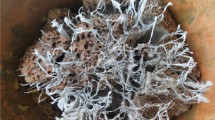Summary
The pH of the gut contents was measured in 52 species of higher termites (Termitidae), representing 36 genera in all four subfamilies. A statistically significant trend was shown from lower termites with low mean gut pH through to the Termitinae with higher mean gut pHs. Elevation of the pH occurred principally in the first and third proctodaeal segments, reaching values as high as 10.5 in 8 soil-feeding genera and 1 wood-feeding genus of Termitinae. Elevation of gut pH within the Termitidae appears to be independent of the general nature of the feeding substrate.
Similar content being viewed by others
References
Bignell, D. E., 1994. Soil-feeding and gut morphology in higher termites. In: J. H. Hunt and C. A. Nalepa (Eds.).Nourishment and Evolution in Insect Societies (pp. 131–157). Boulder: West- view Press.
Bignell, D. E. and J. M. Anderson, 1980. Determination of pH and oxygen status in the guts of lower and higher termites.J. Insect Physiol. 26:183–188.
Bignell, D. E., J. M. Anderson and R. Grosse, 1991. Isolation of facultatively aerobic actinomycetes from the gut, parent soil and mound materials of the termitesProcubitermes aburiensis andCubitermes severus.FEMS Microbiol. Ecol. 85:151–160.
Bignell, D. E., H. Oskarsson and J. M. Anderson, 1980. Distribution and abundance of bacteria in the gut of a soil-feeding termiteProcubitermes aburiensis (Termitidae. Termitinae).J. Gen. Microbiol. 117:393–403.
Bignell, D. E., H. Oskarsson, J. M. Anderson, P. Ineson and T. G. Wood, 1983. Structure, microbial associations and functions of the so-called “mixed segment” of the gut in two soil feeding termites,Procubitermes aburiensis Sjosted andCubitermes severus Silvestri (Termitidae, Termitinae).J. Zool. (London) 201:445–480.
Czolij, R., M. Slaytor and R. W. O'Brien, 1985. Bacterial flora of the mixed segment and the hindgut of the higher termineNasutitermes exitiosus Hill (Termitidae, Nasutitermitinae).Appl. Envir. Microbiol. 49:1226–1236.
Eggleton, P., D. E. Bignell, W. A. Sands, B. Waite, T. G. Wood and J. H. Lawton, 1994. The species richness of termites (Isoptera) under differing levels of forest disturbance in the Mbalmayo Forest Reserve, southern Cameroon.J. Tropic Ecol. in press.
Eutick, M. L., R. W. O'Brien, and M. Slaytor, 1976. Aerobic state of gut ofNasutitermes exitiosus andCoptotermes lacteus, high and low caste termites.J. Insect. Physiol. 22:1377–1380.
Grassé, P. P. and C. Noirot, 1945. La transmission des flagelles symbiotiques et les aliments des termites.Bull. Biol. Fr. et Belg. 79:273–292.
Greenberg, B., J. Kowalski and J. Karpus, 1970. Micropotentiometric pH determinations of the gut ofPeriplaneta americana fed three different diets.J. Econ. Entomol. 63:1795–1797.
Guthrie, D. M. and A. R. Tindall, 1968.The biology of the cockroach. London: Edward Arnold Ltd.
Kovoor, J., 1976. Le pH intestinal d'un termite supérieur,Microcerootermes edentatus (Was., Amitermitinae).Ins. Soc. 14:157–160.
Miller, L. R., 1986. The phylogeny of the Nasutitermitinae (Isoptera: Termitidae).Sociobiology 11:203–214.
Noirot, C., 1992. From wood- to humus-feeding: an important trend in termite evolution. In J. Billen (Ed.),Biology and Evolution of Social Insects (pp. 107–119). Leuven (Belgium): Leuven University Press.
Noirot, C. and J. Kovoor, 1958. Anatomie compare du tube digestif des termites. 1. Sous-famille des Termitinae.Ins. Soc. 5:439–471.
Noirot, C. and C. Noirot-Timothée, 1969. The digestive system. In: K. Krishna and F. M. Weesner (Eds.),Biology of Termites (pp. 49–88). New York: Academic Press.
O'Brien, R. W. and M. Slaytor, 1982. Role of microorganisms in the metabolism of termites.Aust. J. Biol. Sci. 35:239–262.
Randall, M. and T. C. Doody, 1934. Hydrogenion concentration in the termite intestine. In: C. A. Kofoid (Ed.),Termites and Termite Control (pp. 99–104). Berkeley: University of California Press.
Sands, W. A., 1972. The soldierless termites of Africa (Isoptera: Termitidae).Bulletin of the British Museum (Natural history) (Entomology Supplement)18:1–224.
Warhurst, R., 1964.Growth and survival in vitro and in vivo of Endolimax blatte, an entozoic amoeba of cockroaches. Ph. D. Thesis. University of Leicester, U. K.
Wood, T. G. and R. A. Johnson, 1986. The biology, physiology and ecology of termites. In: V. S. Bradleigh (Ed.),Economic Impact and Control of Social Insects (pp. 1–68). New York: Praeger.
Author information
Authors and Affiliations
Rights and permissions
About this article
Cite this article
Bignell, D.E., Eggleton, P. On the elevated intestinal pH of higher termites (Isoptera: Termitidae). Ins. Soc 42, 57–69 (1995). https://doi.org/10.1007/BF01245699
Received:
Revised:
Accepted:
Issue Date:
DOI: https://doi.org/10.1007/BF01245699




